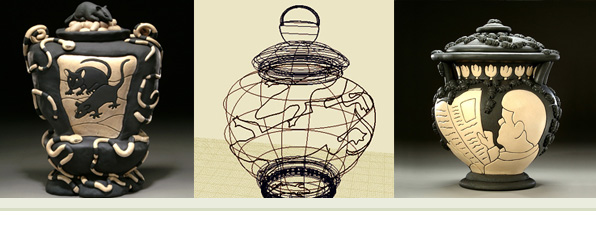Jeff Kell graduated with an MFA from the School for American Crafts in 1992. His ceramic work has been shown internationally in exhibitions like the Fletcher Challenge Ceramics Award, Ceramics Monthly International Competition and the NCECA Clay National. His work has been featured in Ceramics Monthly and Ceramics Art and Perception as well as a number of books including Confrontational Ceramics by Judith Schwartz. In addition to his ceramic work, Jeff consults with industry, designing dinnerware and baking items for such brands as Dansk, Corelle, Corningware and Lenox.
What was most difficult for you when you finished school?
Like most students who put themselves through college, I was carrying a heavy load of debt. This fact, combined with compelling family needs directed me away from the gypsy life required of those who pursue a residency or tenured teaching position. I briefly considered returning to my former career as a full time studio potter, producing wheel thrown and slab constructed items marketed through American Craft Council and Rosen shows. I enjoyed the business and marketing demands of that life, as well as the emotional and financial rewards of constantly selling work. The downside of that career was the strong influence the market exerted on the style and size of my work. Making creative work that might not sell was difficult financially. During graduate study at RIT I began pursuing a more personal vision. After school, I really didn’t want to return to my pre-RIT life; yet the question remained how could I make personally directed work and support my family. The solution presented itself serendipitously. I was talking with the design director of a dinnerware company who was interested in my ceramic background. As it turned out, he preferred hiring ceramic artists as designers because of their understanding of form and function and their knowledge of ceramic manufacturing processes. He hired me as a design consultant and we’ve been working together ever since.
Designing for industry provides steady income, opportunities for overseas travel, involvement with design aesthetics and ceramic processes. I control when and how much I work. Best of all, I have the time and space to pursue my personal vision in the studio, one that is unaffected by the market.
What advice would you give to a young artist?
Focus your life around making work. Live simply and spend as much time as possible in the studio. Don’t allow the pressures of the “real world” to deter you. Find a way to keep learning and growing as an artist. Seek out new ideas and experiences; allow them to inform and clarify your personal vision. Don’t allow your work to be overly influenced by the market or by work you see in books and magazines. Maintain the integrity of your work. Nourish personal contacts and professional friendships; the success of your career depends on them.
Could you comment on having a vision and what it means to be an artist?
If you are an artist, you’ll know it. The need to make art and to express your personal vision is overwhelming. The state of your physical and emotional health is dependent on making. Someone once told me that of all the professions, doctors and artists are the most important; doctors because they explore and heal the human body, artists because they do the same with the human soul.
